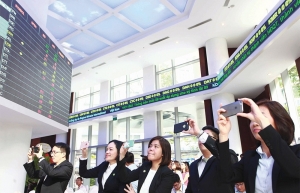Liquidity pressure “substantial” on Vietnam’s banks
Figures from the State Bank of Vietnam (SBV) revealed that by October 17, the volume of mobilised deposits had increased by 5.28 per cent on-year, while credit volume expanded by about 9 per cent. This indicates that lending volume outpaced deposit volume by approximately 3.7 per cent, exerting considerable liquidity pressure on the banking system.
 |
| Liquidity pressure “substantial” on Vietnam’s banks, Source: freepik.com |
Banking consultant Le Hoai An, founder of Integrated Financial Solutions, highlighted that fluctuations in deposit and lending volumes within the banking system often mirror the broader economic climate. “In a context where loans continue to outpace deposits, liquidity pressure on banks is significant,” An said.
He also emphasised that the sharp increase in deposits from economic organisations, following strong credit surges, indicates that capital flows remain heavily reliant on banks, while deposit growth from the residential sector remains limited.
“Deposits from economic organisations have shown negative growth throughout 2024, suggesting that businesses are increasingly reliant on bank capital for liquidity, which is affecting the deposit structure,” An said.
In response to these market developments, the SBV took action in September by injecting a net amount of $2.45 billion through treasury bills and open market operations (OMO), following a similar injection of $2.54 billion in August.
Interbank interest rates also decreased, with the SBV reducing the OMO interest rate by 25 basis points to 4 per cent as of September 16. That month, the average interbank interest rate fluctuated around 3.78 per cent for overnight terms and 3.85 per cent for one-week terms, compared to 4.33 and 4.4 per cent, respectively, in August.
As a result, the overall interest rate level for the third quarter was reduced by around 50 basis points compared to the end of the second quarter.
A senior executive at the BIDV commented that interbank VND interest rates will likely continue to benefit from the SBV’s easing monetary policy, driven by moderate international pressures, a stable exchange rate, and the central bank’s focus on promoting economic growth.
“The SBV is expected to further reduce the OMO interest rate by 25-50 basis points in the fourth quarter, while increasing net injections through open market operations and deposits from the State Treasury to support liquidity,” he said.
However, VND liquidity is expected to remain tight due to weakening capital across a wide range of commercial banks, particularly towards the end of the year when liquidity typically faces increased pressure from higher demand for cash payments driven by seasonal factors.
“The balance between deposit and lending volumes may slightly improve in the fourth quarter, but for the full year, capital raising growth will still lag credit growth by about 2-3 per cent,” the executive added.
In September, only a few banks raised deposit rates by between 0.1 and 0.5 per cent, suggesting that liquidity remained relatively abundant during the first few weeks of the month. However, in the latter half of September and into early October, several lenders, including LPBank, BAC A BANK, Eximbank, and GPBank, increased their highest interest rates to 6.3 per cent per year for regular deposit customers, with these rates often extended as special offers to loyal customers or those with large deposits.
Tran Thi Khanh Hien, head of research at MB Securities, noted that by the end of June, the on-balance-sheet bad debt ratio of the entire banking system had risen by 5.77 per cent compared to the end of 2023. This has prompted banks to raise deposit rates to draw in new capital and ensure liquidity.
By the end of September, the average 12-month interest rate among commercial banks had increased by 13 basis points since the beginning of the year, reaching 5 per cent.
“We believe that resumed credit growth, in the context of accelerated production and investment in the final months of the year, will exert further pressure on banking system liquidity, potentially leading to higher input interest rates,” Hien said.
However, low inflation and anticipated rate cuts by the US Federal Reserve could provide additional room for monetary easing in Vietnam. “Based on these factors, we forecast that the 12-month deposit interest rate at major commercial banks could rise by another 20 basis points, fluctuating between 5.1 and 5.2 per cent by the end of 2024,” Hien added.
 | Fed rate cut expands Vietnamese monetary policy flexibility The decision to cut interest rates by 50 basis-point in last week's Fed meeting is expected to have several positive impacts on the Vietnamese economy, specifically by alleviating exchange rate pressures and allowing the State Bank of Vietnam to implement a more accommodative monetary policy. |
 | US stock momentum bodes well for others The US Federal Reserve will meet in early November and is likely to cut interest rates again, which is expected to have a positive impact on the stock market in Vietnam. |
What the stars mean:
★ Poor ★ ★ Promising ★★★ Good ★★★★ Very good ★★★★★ Exceptional
Related Contents
Latest News
More News
- Gold market reform advances as SBV receives applications for bullion production (December 30, 2025 | 12:07)
- EVN and AFD sign credit agreement for Vietnam’s first pumped storage hydropower plant (December 30, 2025 | 10:06)
- Techcombank Priority Visa Signature unlocks a higher standard of living (December 29, 2025 | 16:44)
- Tax sector wraps up 2025 and sets priorities for next year (December 25, 2025 | 14:00)
- A tipping point for digital and hybrid wealth management in Vietnam (December 23, 2025 | 13:33)
- $250 million deal targets women-owned SMEs, sustainable agriculture (December 22, 2025 | 17:40)
- Stock market posts resilient 2025 performance (December 19, 2025 | 18:17)
- Citi Vietnam receives 2025 AmCham CSR recognition (December 19, 2025 | 16:35)
- As global green supply chain reshapes, will Vietnam be left behind? (December 19, 2025 | 08:00)
- Banks gear up for massive capital increases (December 18, 2025 | 17:04)

 Tag:
Tag:



















 Mobile Version
Mobile Version